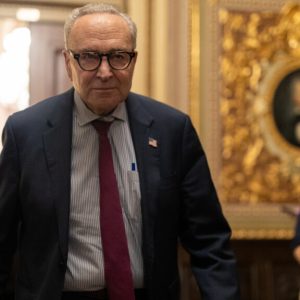Senate Minority Leader Chuck Schumer found himself in an uncomfortable situation on the Senate floor when Republican Sen. Bernie Moreno (R-Ohio) confronted him over a proposed “fix” for the Affordable Care Act (ACA) subsidies, which have become a contentious issue amid the ongoing 39-day government shutdown. Schumer had suggested a one-year extension of taxpayer-funded ACA subsidies, aimed at ensuring that Americans who rely on these benefits would continue receiving support while negotiations over the broader government funding stalemate continued. However, when pressed by Moreno for details, Schumer admitted that the proposal had not been formalized in writing. He explained that the plan was simple, consisting of only two sentences that would extend the ACA benefits for one year, leaving specific provisions to be negotiated afterward. This lack of a written proposal highlighted the uncertainty and improvisational nature of Schumer’s approach, which became a focal point for criticism by Republicans on the floor.
During the exchange, Moreno pointed out a significant issue with Schumer’s plan: it appeared to have no income caps. This meant that wealthy individuals earning millions annually could still qualify for taxpayer-subsidized healthcare, a provision Moreno and other Republicans argued was unfair and fiscally irresponsible. Schumer responded by emphasizing that the one-year extension was intended to prevent immediate hardship for current ACA participants, and that negotiations regarding income limits and other details would take place after the extension was enacted. When Moreno questioned whether this meant millionaires could benefit from these subsidies for an entire year, Schumer accused him of focusing on billionaires rather than the people currently in need and then abruptly left the chamber. The confrontation underscored the partisan tension surrounding ACA funding and the broader debate about government spending priorities during a prolonged shutdown.
Moreno further criticized Schumer for avoiding substantive negotiation, raising concerns about what he described as “zero dollar premiums” under ACA subsidies. He claimed these subsidies had been linked to high levels of fraud, raising questions about taxpayer accountability and the integrity of the system. Moreno also intended to ask whether the subsidy payments would flow directly to individuals or go to insurance companies, a distinction he argued was central to any meaningful reform. The exchange revealed not only the complexities of the ACA funding mechanism but also the broader political battle lines, with Democrats seeking to protect the program and Republicans emphasizing oversight, accountability, and direct benefits to citizens rather than insurance corporations.
Amid the Senate floor confrontation, former President Donald Trump entered the debate with a proposal that reframed the discussion entirely. Trump suggested redirecting hundreds of billions of dollars in ACA subsidy payments away from insurance companies and directly to American citizens. He argued that this would allow people to purchase their own healthcare while leaving them with surplus funds, describing it as a method to bypass “big insurance” and increase consumer choice. Trump characterized the existing system as inefficient and wasteful, emphasizing the idea that taxpayer money should empower individuals rather than enrich insurance corporations. This intervention added a new dimension to the debate, positioning Trump as an advocate for direct-to-consumer healthcare reforms and drawing renewed media attention to the ongoing shutdown negotiations.
Trump’s proposal was quickly embraced by conservative commentators, who praised it as a politically savvy and innovative approach to healthcare reform. By reframing the discussion as a battle between “healthcare for the people” versus protecting insurance company profits, the idea resonated with voters concerned about rising costs and limited choice under the ACA. The proposal also aligned with longstanding Republican priorities of reducing government involvement in healthcare, promoting individual autonomy, and incentivizing competition within the private insurance market. By tying this concept to the ongoing shutdown, Trump effectively placed pressure on Democrats, suggesting that continued resistance to reform was aligned with corporate interests rather than the needs of ordinary Americans.
Senator Rick Scott (R-FL) quickly followed up on Trump’s plan, announcing that he would draft legislation to implement the direct-payment proposal. Scott described a system in which funds would be distributed to Americans through Health Savings Account-style arrangements, allowing individuals to purchase healthcare according to their preferences while promoting competition among providers. He argued that this approach would drive down costs and increase efficiency by empowering consumers and reducing reliance on insurance company intermediaries. The development of new legislation based on Trump’s concept highlights the dynamic interplay between executive influence, legislative strategy, and partisan priorities, illustrating how policy proposals in one branch of government can rapidly shape the political landscape in another.
The confrontation between Schumer and Moreno, combined with Trump’s high-profile intervention and Scott’s proposed legislation, demonstrates the complex and highly partisan nature of healthcare policy in the United States. The debate over ACA subsidies is not just about financial logistics or program mechanics; it reflects broader ideological differences regarding government responsibility, fiscal accountability, and the role of private markets in healthcare provision. As negotiations continue, the standoff underscores the challenges of achieving bipartisan agreement in an era of heightened political polarization. Ultimately, the events highlight how individual lawmakers, party leaders, and former presidents can influence public policy debates, and how proposals like redirecting ACA subsidies directly to citizens may redefine the terms of engagement for healthcare reform in America.





